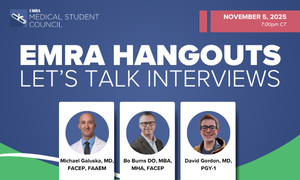Practicing for Disaster: The Mass Casualty Drill
Kaitlin Lipner, MSIV, University of Connecticut School of Medicine
A new patient arrives at the emergency department (ED) every 45 seconds. Other than the occasional cholecystitis and stable angina, almost all of them have the same chief complaint: a seemingly simple upper respiratory tract infection. The only peculiar part of the patient presentation is that almost all say they were on a flight just hours before. About five minutes into the patient encounter, however, those same patients are coughing up blood. It eventually becomes clear that the emergency medicine (EM) residents are managing an outbreak. But in the amount of time it took to come to that conclusion, how many healthy patients and staff have been exposed? What parts of the ED remain uncontaminated? What do you do when an outbreak hits your ED?
This is an example of the Mass Casualty Drill, an annual event at Hartford Hospital’s Center for Education, Simulation and Innovation (CESI), where University of Connecticut (UConn) EM residents train in disaster medicine via a simulated mass casualty event. The residents are not warned in advance of the planned scenario in order to mimic the conditions they would face if the event were a reality. In 2018, the drill simulated the fallout from an explosion at a nearby concert arena. Each patient arrived with cinema-quality fake wounds representing anything from open fractures to blunt cardiac injury. At about the midway point of that drill, there was a second explosion within the simulated hospital. In a previous year, in the midst of the mass casualty drill, an active shooter was added to the simulated scene.
Residents are tasked with both patient triage and management as well as with implementing and activating the necessary administrative protocols. In this year’s event, the residents even had a simulated phone call to the Centers for Disease Control and Prevention (CDC). The event unfolds for about an hour and then the residents have a debriefing session with faculty. In this year’s case, UConn’s disaster medicine fellow and EM attendings were joined by infectious disease attendings to discuss the management of this simulated outbreak of Middle East Respiratory Syndrome (MERS).
Prior to this year, the Mass Casualty Drill had been solely focused on resident training with medical student involvement was limited to volunteering as victims. UConn’s Emergency Medicine Interest Group (EMIG) saw an opportunity to increase the educational experience of the volunteering students. Working with organizer Dr. David Ruby, we added educational components geared specifically towards medical students including a pre-lecture on disaster medicine and participation in the debrief session alongside the residents. As volunteer victims, the students had an ideal vantage point to observe the residents at work: in the middle of the action. They were costumed with subtle makeup: a pale face and rosy cheeks to mimic the appearance of victims of MERS. Residents were caught off-guard because they were expecting to deal with traumatic injuries based on knowledge of previous years’ disaster drills.
One of the major learning points I took away from the drill was the importance of clear communication. Trying to communicate complex plans and information as the situation rapidly evolved was one of the most difficult parts of the drill. I also learned an incredible amount about the management of infectious disease: both within the ED and at the hospital administration level. We even discussed how the CDC would become involved. Additionally, in the midst of the MERS patients, there were also patients with chief complaints that are common to the ED on a daily basis, adding to the challenge for the residents. I truly came to appreciate the teamwork necessary to manage a mass casualty event: all of the residents were working together and supporting each other. Witnessing this reminded me of one of the most prominent reasons I chose to pursue EM: the sense of camaraderie and teamwork that exists within the specialty.
After planning this event, I encourage anyone who is interested in creating new educational programming to find out what events already exist locally and to ask themselves if the event can be enhanced for medical students. Our EMIG has already met and discussed ways to improve the event for next year and we are looking forward to this becoming an annual collaboration.
Related Content






